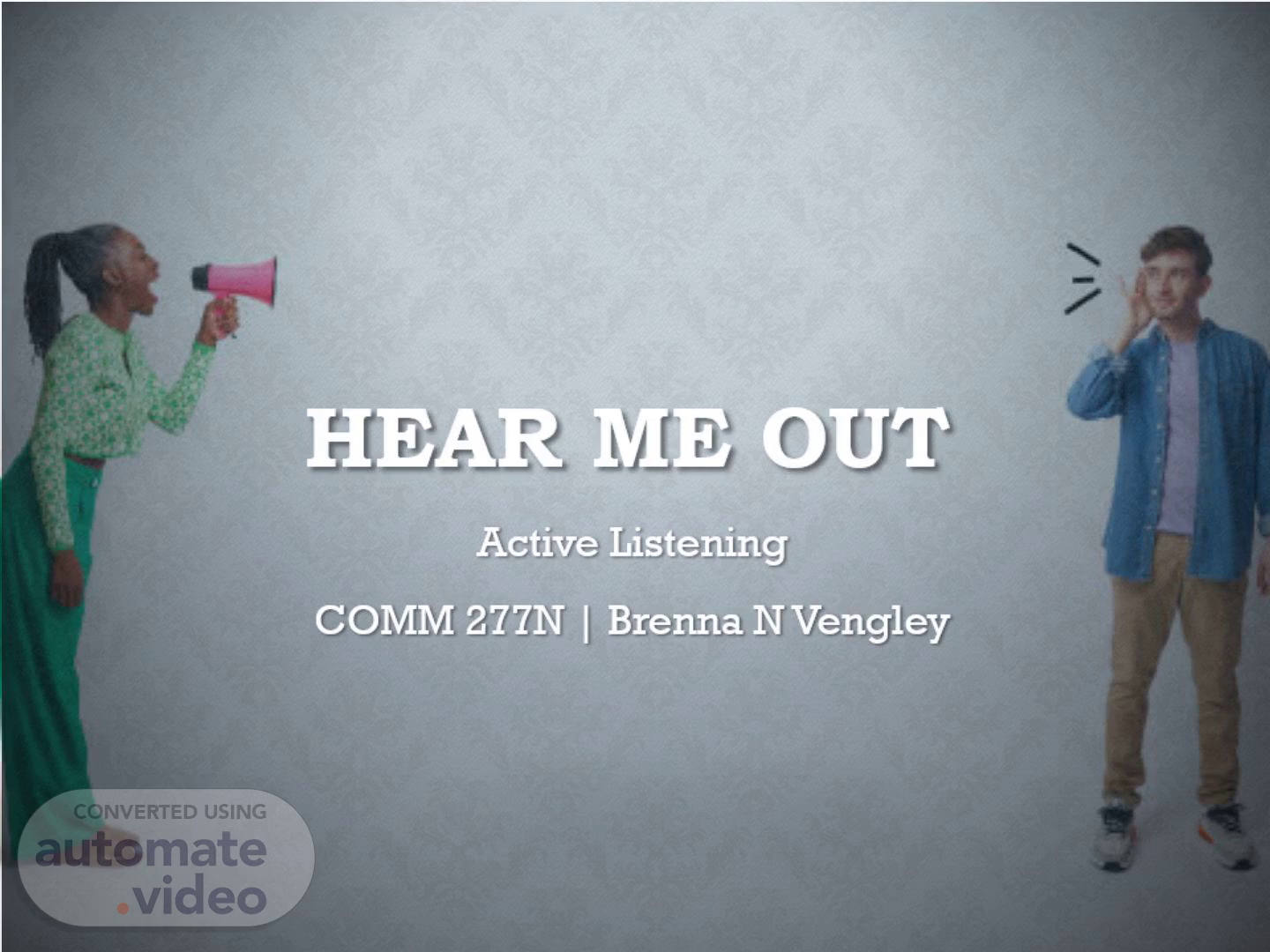Scene 1 (0s)
[Virtual Presenter] Hello everyone. I’m Brenna, and today I will be presenting how to improve listening skills, with a focus on active listening. This is an important skill not only in our personal lives but also in our academic and professional roles. As nursing students and future healthcare professionals, listening is one of the most essential tools we have..
Scene 2 (24s)
[Audio] Listening is often overlooked, but it is a core element of effective communication. Active listening means being present, showing empathy, and engaging with the speaker. Without it, misunderstandings and missed opportunities can occur..
Scene 3 (42s)
[Audio] My thesis today is that improving listening skills is essential for effective communication, fosters deeper understanding in personal and professional relationships, and enhances our critical thinking abilities..
Scene 4 (58s)
[Audio] This is a chart I found that shows the cycle of active listening. The first step is Invite. This means creating a welcoming environment where someone feels safe to share. We do this by being warm, open, and modeling respect. When people sense that we are genuinely present and interested, they are more likely to open up and communicate honestly. Next is Empathize. This step is all about acknowledging the speaker's feelings. It's not enough to just hear the words — we need to recognize the emotions behind them. By showing empathy, whether through words like 'I can understand why you'd feel that way' or through body language, we validate the person's experience and make them feel heard. The third step is Encourage. Here, we validate both the person's feelings and the situation they are going through. This can be as simple as nodding, using affirming words, or asking supportive follow-up questions. Encouragement helps the speaker feel comfortable continuing the conversation and builds trust. The fourth step is Reflect and Clarify. This is where we show that we are truly listening by reflecting back what we've heard and asking clarifying questions. For example, saying something like, 'So what I'm hearing is that you felt overwhelmed during that meeting, is that right?' Not only does this prevent misunderstandings, but it also deepens the conversation. The final step is Explore. At this stage, both people can move forward by inviting solutions, discussing options, and identifying next steps. This is especially important in professional settings like healthcare, where after truly listening to a patient or colleague, we can work together to solve problems or create action plans.
Scene 5 (2m 51s)
[Audio] Now I will discuss some strategies to help you become a better active listener. The first strategy is maintaining focus on the speaker..
Scene 6 (3m 1s)
[Audio] That means giving our full attention, eliminating distractions like phones or multitasking, and resisting the urge to plan what we'll say next. When we stay mentally and emotionally present, we show the speaker that their message matters. This is especially important in professional settings—such as patient interactions—where even small distractions can lead to big misunderstandings. We can strengthen active listening by practicing mindfulness, pausing before responding to fully process what's being said, and reflecting back key points to validate the speaker..
Scene 7 (3m 38s)
[Audio] Next strategy is to engage with empathy. Follow These 9 Tips To Be A Better Listener - Mindworks Counselling.
Scene 8 (3m 47s)
[Audio] Empathy is a critical component that elevates listening to a more profound level, allowing listeners to connect beyond mere words. This emotional connection fosters an environment of mutual understanding and respect between the listener and the speaker (Weger.).
Scene 9 (4m 6s)
[Audio] This means listening not only to the words, but also to the emotions behind them. We can show empathy through verbal affirmations like 'I understand,' but also through nonverbal cues like eye contact, nodding, and open body language according to Bodie, are equally important to validate the speaker's feelings and create a supportive atmosphere. Empathetic listening helps us connect on a deeper level, fosters mutual respect, and can defuse conflicts before they escalate..
Scene 10 (4m 38s)
[Audio] To truly embody the principles of active listening, one must also prioritize the delivery of effective feedback. This aspect involves crafting thoughtful responses that not only summarize the key takeaways from the conversation but also clarify any ambiguities, which is vital to ensuring accurate comprehension (Brownell, 2012)..
Scene 11 (5m 3s)
[Audio] This doesn't mean just saying nice things—it means confirming understanding by paraphrasing what was said, asking clarifying questions, and offering constructive, respectful responses. Feedback should align with the speaker's goals, not just our own. In healthcare, this is critical because miscommunication can affect patient outcomes, teamwork, and trust between professionals..
Scene 12 (5m 28s)
[Audio] Reviewing the strategies we just discussed. You'll want to practice mindfulness to improve your focus while being spoken to, pause before responding so you can fully process and understand the message, and lastly, reflect back—asking ourselves after conversations how well we listened and how we can improve. These small but intentional practices add up to big improvements over time..
Scene 13 (5m 56s)
[Audio] To conclude, active listening is more than just a communication skill—it's a foundation for building trust, understanding, and respect. By focusing on the speaker, engaging with empathy, and providing constructive feedback, we can improve relationships in every area of life. In healthcare especially, active listening strengthens teamwork, prevents errors, and makes patients feel heard and cared for. It's a skill worth practicing every day..
Scene 14 (6m 25s)
[Audio] Here are the references that I used.. References.
